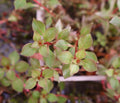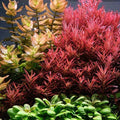How to Clean and Quarantine Your New Aquarium Plants
The general belief among aquarists is that aquarium plants don't need any particular care before being introduced to the tank. Typically, people toss new and unusual items into the tank without properly treating them, then wonder why their fish become ill.
Have you ever noticed something unusual in your tank following the addition of a new aquarium plant? Does your fish get sick or die without your knowledge? If so, this article will include aquarium plant quarantine and other crucial but sometimes overlooked information.

4 Reasons to Quarantine New Plants
-
Snail infestation.
Seriously, speaking, this is the most common reason. Snails frequently travel with aquatic plants and settle in your aquarium. For instance, Malaysian Trumpet Snails, Pond Snails, and Bladder Snails are all quite skilled at it. You have no idea why or how all these fresh snails appeared out of thin air! What could go wrong, after all?
-
Parasites and Predators
Such creatures as dragonflies or damselfly nymphs, for instance, caused several aquarists to lose their fish and shrimp colonies. They are excellent natural hunters and can catch fish and shrimp that are the same size as them. Nymphs are quite difficult to remove from your aquarium once they have entered. The wisest course of action is to avoid it.
-
Pesticides and Contaminations
In some cases, customers bought fresh plants and immediately added them to their tanks. They thus saw significant fish and shrimp die-offs shortly after. This is most likely a result of the chemical treatments used on these plants to get rid of parasites. However, the chemical leftovers still have the potential to destroy your aquarium.
-
Algae, Fungus, and other Diseases
Unfortunately, several other people also experienced it. On the Internet, there are countless stories to choose from. I, therefore, hope that I don't need to persuade you any longer.
Best Protocol for Quarantining Aquatic Plants
Fortunately, the plant quarantine period is shorter than the fish quarantine period. Keep your new plants in a separate tank that is empty of fish.
Fish parasites and bacteria can easily be eradicated without treatment since they need a fish host to exist. Depending on the temperature of your tank, your plants will be prepared to go into their new location in two to three weeks.
During this period, you may feed them more fertilizer and make sure they are healthy so they can withstand any more nibbling that may occur.
Importance of Aquarium Plants Quarantine
First and foremost, the plant you are purchasing from the shop or ordering online needs to be trustworthy. Additionally, make sure the plants you buy are rooted and in good health so they can grow well in your tank.
Include some aquarium plants in your tank if you want to give it life. A few plants in the tank may transform it into something quite beautiful. Numerous plants, both large and small, are appropriate for aquariums. However, you must exercise caution when purchasing aquarium plants.
The advantages of aquarium plants are numerous.
- Activate and revitalize any lifeless tank.
- Enhance the tank's ecosystem.
- Give the aquatic animal a place to hide and play.
- Make oxygen out of carbon dioxide
- Enhance overall water quality
- Enhance the tank's appearance.
While adding aquarium plants to the tank has many benefits, if the proper precautions are not taken, they could also endanger the fish's health and existence.
The Correct Method for Quarantining Aquarium Plants
Treating the young plants first is the best method to begin the quarantining procedure. You might employ the following remedies for this.
Salt Dip
Non-iodized salt, also known as Molla salt, should be combined with water in a basin or bucket at a ratio of 1 tablespoon per gallon. Give it a good stir.
Take your plants outside, soak them for approximately 10 minutes in the solution, and then give them a good rinsing in clean water. Any snails or snail eggs on the plants are killed with this technique.
Hydrogen Peroxide Solution
You will need a hydrogen peroxide solution for this approach, which is easily found at any pharmacy. Hydrogen peroxide should be added to a bucket of water at a rate of 2 mL per gallon.
For about 10 minutes, dip your plants in the mixture, and then thoroughly rinse them with clean water. For highly sensitive plants, you might wish to use a lower concentration (1 ml/gal). Keep in mind that too much hydrogen peroxide will damage your plants.
Potassium Permanganate
Potassium permanganate is also widely available in pharmacies. Just mix some of it into a bucket of water and add more until the water is a deep pink color. After 10 minutes, remove your plants from the liquid by dipping them in it again. After that, thoroughly rinse the plants. Most algae will die as a result.
Alum
Simply combine a little amount of alum with a pail of water and soak your plants for two to three days to use this strategy. After that, remove the plants and give them a good rinsing in clean water.
Quarantining Aquarium Plants
Aquarium plant quarantining is a pretty easy operation. Simply purchase a non-fish quarantine tank and keep the plants there for at least three weeks. Just make sure the tank has enough light and is kept at a consistent temperature. To make sure the plants get all the nutrients they require, you will also need to apply a small amount of liquid aquarium fertilizer.
Final Thoughts
There are other contradictory steps and directions for various sterilization techniques; however, the ones listed above are a handful. Plant quarantining is essential for maintaining the safety of fish and shrimp. May this blog article educate anyone curious about planted tanks and aid in their fresh start!

















Interesting article! creating friendly culture is very necessary these days as many employees are facing issues in their jobs. We provide Pharmacist Jobs at: https://locumco.com.au/positions-vacant/